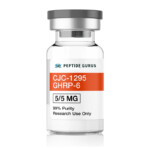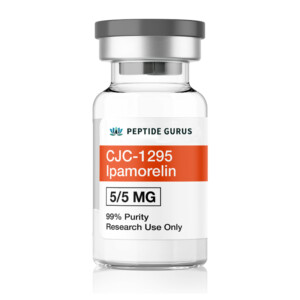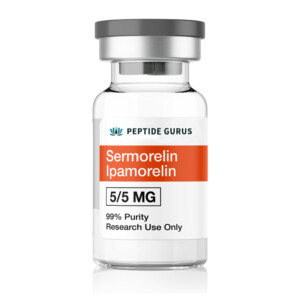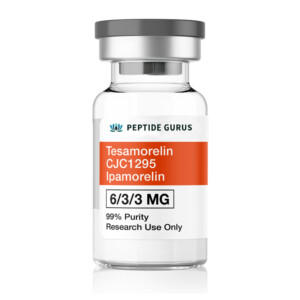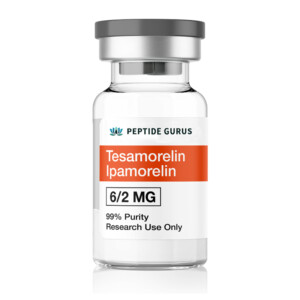CJC-1295
CJC-1295 is a synthetic analogue of growth hormone releasing hormone (GHRH) andbinds to the GHRH receptor in the anterior pituitary gland. it is well known for its ability topreserve physiologic pulsatile secretion of GH while boosting GH levels. GHRP-6 is asynthetic analogue of ghrelin and binds to the growth hormone secretagogue receptor.
Research has shown that in combination, the two peptides work synergistically to substantially boost levels of GH. GHRP-6 acts as a baseline GH booster, increasing theset level of GH, en otras palabras, GHRP-6 ensures that the lowest level that GH drops to ishigher than under normal physiologic conditions. CJc-1295 will then boost GH release ina pulsatile manner, using the new higherke baseline set by GHRP-6 as the trough andcreating proportionally elevated peaks[1], [2].
As an added benefit, research has shown that GHRP-6 stimulates appetite and improvessleep quality. increased food inta allows for better use of increased GH levels as thereis more raw material from which to build muscle, improve bone density, and promotegrowth. Sleep is the time during which animals are most receptive to the effects of GHand thus improved sleep quality helps to ensure that GH has the most impact onfunctions like wound healing and immune system regeneration. Both peptides have alsobeen linked to improved wound healing and protection of nervous tissue[3]-[6].
Acerca del autor
La literatura anterior fue investigada, editado y organizado por el Dr.. mi. logan, MARYLAND. Dr. ELogan tiene un doctorado de la Facultad de Medicina de la Universidad Case Western Reserve y una licenciatura en biología molecular.
Revista CientíficaAutor
Márta Korbonits graduated in Medicine in Budapest and undertook her early clinicaltraining at the Internal Medicine Department of the Postgraduate Medical School,Budapest. She joined the Department of Endocrinology at St. Bartholomew’s Hospitalunder the mentorship of Professors Ashley Grossman and Michael Besser. Her MD andlater PhD studies contributed to the understanding of the effects of growth hormone secretagogues on hypothalamic hormone release and the nature and causes of pituitary tumorigenesis. She was awarded an MRC Clinician Scientist Fellowship and commenced studies that produced novel insights into ghrelin physiology and genetics. Her finding srelated to the regulation of the metabolic enzyme AMPK by ghrelin, cannabinoid andglucocorticoid opened a new aspect of hormonal requlation of metabolism. En 2008. MartaKorbonits was promoted to Professor of Endocrinology and Metabolism and since 2012has led the Centre of Endocrinology at Barts and the London School of Medicine. en 2016, Márta Korbonits was appointed a Deputy Head of the William Harvey ResearchInstitute. Professor Korbonits continues to integrate human studies alongside withlaboratory-based research and has pioneered several projects in translational medicine.
Márta Korbonits is being referenced as one of the leading scientists involved in theresearch and development of GHRP-6. De ninguna manera este médico/científico respalda o defiende la compra, venta, o uso de este producto por cualquier motivo. No hay afiliación o relación, implícito o no, entre PEPTIDE GURUS y este doctor. El propósito de citar al médico es reconocer, recoanize, y damos crédito a los exhaustivos esfuerzos de investigación y desarrollo realizados por los científicos que estudian este péptido.. MártaKorbonits is listed ini[7] bajo las citas referenciadas.
Citas referenciadas
[1]METRO. lonescu and L. A. frohman, “Pulsatile secretion of growth hormone (GH)persiste durante la estimulación continua por CJC-1295, a long-acting GH-releasinghormone analog,”J.Clin.Endocrinol. Metab., vol.91, no.12,pp.4792-4797, Dec2006.[PubMed]
[2]S.L.Teichman, A. Neal, B.Lawrence, C.Gagnon, J.-P. Castaña, y l. AFrohman, “Prolonged stimulation of growth hormone (GH) and insulin-like growthfactor l secretion by CJC-1295, a long-acting analog of GH-releasing hormone, inhealthy adults,”J.Clin.Endocrinol. Metab., volumen. 91,no.3, páginas 799-805, Mar. 2006[PubMed]
[3] Y. Mendoza Marí et al., “Growth Hormone-Releasing Peptide 6 Enhances theHealing Process and lmproves the Esthetic Outcome of the Wounds,” PlasticSurgery International, 2016.[En línea]. Disponible:https://www.hindawi.com/journals/psi/2016/4361702/.[Accedido: 23-mayo-2019]
[4]METRO. Fernández-Mayola et al., “Growth hormone-releasing peptide 6 preventscutaneous hypertrophic scarring: early mechanistic data from a proteome study.Int. Wound J., vol.15,no.4, pp.538-546,Aug.2018.[PubMed]
[5]H.-J. Huang et al., “The protective effects of Ghrelin/GHSR on hippocampal neurogenesis in CUMS mice,”Neurofarmacología, Puede 2019.[PubMed]
[6]norte. Subirós et al..“Assessment of dose-effect and therapeutic time window inpreclinical studies of rhEGF and GHRP-6 coadministration for stroke therapy,Neurol. Res., vol.38, no.3, pp.187-195, Mar. 2016.[PubMed]
7]Korbonitas, Marta, and Ashley B.Grossman.“Growth Hormone-ReleasingPeptide and lts Analogues.” Trends in Endocrinology& Metabolism, volumen. 6, No. 2,Mar.1995, pp.43-49 [PubMed]
TODOS LOS ARTÍCULOS Y LA INFORMACIÓN DE PRODUCTOS PROPORCIONADOS EN ESTE SITIO WEB SON SÓLO PARA FINES INFORMATIVOS Y EDUCATIVOS.
Los productos ofrecidos en este sitio web se proporcionan únicamente para estudios in vitro.. Estudios in vitro(latín: en cristal) se realizan fuera del cuerpo. Estos productos no son medicamentos ni drogas y no han sido aprobados por la FDA para prevenir, tratar o curar cualquier condición médica, dolencia o enfermedad. La introducción corporal de cualquier tipo en personas o animales está estrictamente prohibida por la ley..



